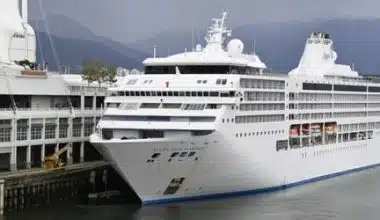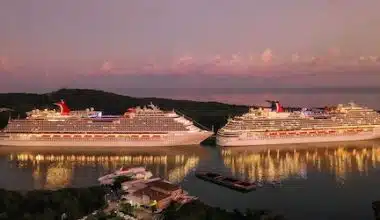The Dalmatian Coast in Croatia has become a popular alternative to the more expensive and busy Mediterranean Coast for savvy travelers, and a Croatian cruise onboard a small luxury yacht is one of the best ways to experience the gorgeous and fascinating region. Sailing Croatia cruises is like taking a cruise from one UNESCO World Heritage Site to the next, stopping along the way to bathe at hidden beaches, discover deserted islands, and browse alleyways dotted with lovely cafés and Venetian architecture.
Luxury cruises around the Croatian coast will demonstrate why the country has emerged as the newest European tourism hotspot. Croatia sailing cruises feature UNESCO World Heritage Site city excursions, visits to little island fishing towns, and plenty of time resting on the beach and swimming in crystal-clear waters.
Best Croatia Cruises and Places To Visit
Most Adriatic Croatia cruises will include some or all of the following features:
#1. Split
Split, a popular launching point for island-hopping cruises along the Dalmatian Coast, hides a wealth of aesthetic and historical gems within its walls. The UNESCO World Heritage Site and active port city, combines the ancient and the modern, making it one of Europe’s most fascinating and evocative cities. Split’s claim to fame is Diocletian’s Palace, which is dripping with Roman remains. Despite the fact that it dates back to the year 305, this is not a musty museum. The Palace is a vibrant section of the city, with laundry hung from balconies and music emanating from lively eateries.
#2. The Makarska Coast
The Makarska Coast (also known as the “Makarska Riviera”) is Croatia’s most popular mainland resort. Makarska, which has beautiful beaches and a stunning mountain backdrop, also has some of the greatest wines in the region. Wandering the streets of Makarska allows you to see various churches and cathedrals, as well as two old monasteries. Visitors looking for action can go to nearby Cetina for whitewater rafting and ziplining.
#3. Korula Island
Korula Island, which is covered in thick forest and dotted with mountains, is home to Korula Town, which is recognized as both the birthplace of Marco Polo and one of the nicest towns in the region. The walled town boasts terracotta roofs that appear to burn in the sun, which contrasts with the blue of the Adriatic. Sunbathers will find a number of small beaches east of town, while culture seekers can stay within the town walls and visit the numerous churches, art shops, and the Marco Polo House.
#4. Mljet Island
Mljet Island is a naturalist’s dream. The Mljet National Park covers one-third of the island’s surface and is dotted with limestone mountains. Visitors can hike, cycle, or take a boat ride on one of the park’s two saltwater lakes. The island is also home to a variety of animals, including wild boar, hare, and deer, as well as grouper and the endangered monk seal. Mljet’s shoreline is littered with lovely beaches, including Saplunara at the island’s southeastern tip, which is regarded as one of the best in the region.
#5. Hvar Island
Hvar Island is a popular vacation destination for Croatians, and it’s easy to understand why. In addition to glittering coves and sweet-smelling lavender fields, Hvar Island, has Hvar Town, where you can tour the Old Town, appreciate Venetian architecture, and trek to the hilltop Fortica to take in the views. After a delicious supper at one of the town’s restaurants, head out to explore the adjacent Pakleni Islands’ pristine beaches before returning at sundown to enjoy dancing and cocktails at an after-hours beach bar.
#6. Stari Grad
Stari Grad on Hvar Island is located at the end of a lengthy bay and offers a more tranquil, unhurried alternative to Hvar Town. Founded by the Greeks in 384 BC, is the region’s oldest settlement, and its name literally means “Old Town.” Outside of this majestic and attractive town, fields were still divided in the ancient Greek manner.
Due to its position as a military facility, Vis was closed to tourists until 1989. Visitors may now enjoy this largely unspoiled island, complete with beautiful beaches and an amazing inland mountain chain. Vis is known for its Venetian-Gothic architecture and the white-walled Our Lady of Spilica church. The island also contains the ruins of Issa, an ancient Greek colony and Croatia’s earliest urban center.
#7. Bol
Bol is a small hamlet on the island of Bra that, despite being a basic fishing village, has become a famous tourist stop due to its closeness to Zlatni Rat, one of the Adriatic’s most iconic beaches. This golden sand beach, like a blade plunging into the water, changes shape with the tide. Aside from bathing, the waters and conditions here are ideal for windsurfing.
#8. Dubrovnik
Dubrovnik is usually the starting or stopping point for Dalmatian Coast cruises, but it’s worth staying an extra day or two to explore this UNESCO World Heritage site. The city is famous for its huge Old City Walls as well as serving as a stand-in for King’s Landing, the fictional city featured in the Game of Thrones television series. Visitors can take city excursions that take them along the walls or to Game of Thrones-related locations. Visitors looking for a place to get a coffee or a drink of local wine can travel to the pedestrianized Stradun or ride the municipal cable car for panoramic views of the city and the surrounding sea.
When is the Best Time to Sail in Croatia?
The Dalmatian coast of Croatia has a distinct peak and off-season. Croatia’s peak season runs from June to August, when the sun shines brightly but crowds are larger and prices are often higher. Croatia’s off-season runs from October to April when many stores, restaurants, and hotels are closed and possibilities for island hopping are restricted.
The months of May and September are ideal for visiting Croatia’s coast and islands since rates are sometimes lower, people are thinner, and facilities are still open.
How to Travel to Croatia
Three international airports serve Croatia’s coast: Zadar, Split, and Dubrovnik. All three airports are accessible by direct flight from any of more than a dozen European countries. Flights arriving from outside Europe must connect in Zagreb or another European city before continuing to the coast.
From Where Do Croatia Cruises Depart?
Dalmatian coast-sailing cruises often depart from Split or Dubrovnik. If your cruise departs from Split, you will arrive at Split International Airport, but Dubrovnik has its own international airport.
Tips For Croatia Cruises
- Plan ahead of time because Croatia has a distinct peak and off-season, which may affect the availability of premium Adriatic cruises. Luxury cruises should be booked well in advance during peak season. Certain cruise options may be unavailable during the off-season.
- Select the best trip for you. If you’re looking for adventure, include Mljet Island and a trip to Cetina, near Makarska, on your schedule. Art aficionados should spend some extra time in Split, while those who want to party until the sun comes up should visit Hvar Island.
- It is best to arrive a day or two before your Croatian small ship cruise to avoid any unexpected delays.
- Summers on the Dalmatian Coast can be hot and sunny, so bring sunscreen, sunglasses, and a sturdy hat.
- Croatia’s national currency is the kuna. ATMs are widely available, and larger hotels, restaurants, and shops accept credit cards, although smaller shops and accommodations only accept cash.
- Citizens of the European Union can enter Croatia with their ID cards, while all other tourists must have a passport that is valid for at least three months beyond the date of departure. Visas are not often required for most travelers visiting for 90 days or less, though those from China, India, South Africa, Russia, and Turkey will require one.
- Take a look at the small ship cruise itineraries available in Croatia and get in touch with our reservations staff to plan your next vacation.
What Currency Is Used in Croatia?
Croatia joined the Eurozone in January 2023. Euros are required for all purchases made on land and on board the ship. It is recommended that you bring enough euros to pay the expense of meals and beverages on some of Croatia’s smaller islands.
You may use credit cards and withdraw money from ATMs in the cities of Dubrovnik, Split, and Hvar. Credit cards, however, are not accepted on board the cruise. Your cruise director can point you in the direction of local currency exchange offices and ATM machines.
Is a Visa Required for Croatia?
Visitors from the United States, Canada, the United Kingdom, Australia, and New Zealand do not need a visa to visit Croatia. South African visitors, on the other hand, require a Schengen visa to enter the nation. Please check that your passport is valid for at least six months and that your visa, if required, is also valid before departing for your luxury Croatian cruise. It is also your duty to obtain travel insurance.
What Are the Customs of Tipping in Croatia?
It is typical to leave a tip as a show of appreciation and gratitude for the crew’s excellent service. Your cruise fare does not include gratuities. The captain will leave two envelopes in your cabin at the end of the cruise, one for the crew and one for the cruise director.
We recommend that you leave a tip of:
- Ship’s crew: €15–20 per person each day
- The cruise director charges between €6 and €8 per guest per day.
Please keep in mind that tips should only be paid in cash.
Conclusion
Croatia’s greatest asset is its adaptability. Despite the fact that the country is more popular than ever, crowds are manageable even during peak summer months. The best months to visit are April, May, September, and October, when the weather is mild and the sun shines brightly, but most European tourists are still at home.
While the Dalmatian Coast rarely turns chilly, Zagreb and other inland cities have four different seasons. If you plan to cruise to Croatia between April and October, make sure you pack appropriately.
With over 1,200 islands off Croatia’s coast, there are numerous public ferry choices for getting about and island-hopping. Check timetables ahead of time, as certain ferry companies may not run regularly during the day or throughout the week.
- 11+ Best Places to Travel in November 2023 (Detailed List)
- TOP GUIDED TOUR PACKAGES IN 2023
- THE BEAUTIFUL MOUNTAINS IN CANADA: Facts & History
- BEST CRUISE LINE FOR COUPLES IN 2023
- BEST CARIBBEAN CRUISE DEALS IN 2023-2024






